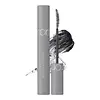What's inside
What's inside
 Key Ingredients
Key Ingredients

 Benefits
Benefits

No benefits
 Concerns
Concerns

 Ingredients Side-by-side
Ingredients Side-by-side

Water
Skin ConditioningAcrylates Copolymer
Alcohol Denat.
AntimicrobialBeeswax
Emulsion StabilisingPEG-15 Glyceryl Stearate
EmulsifyingCopernicia Cerifera Wax
Butylene Glycol
HumectantKaolin
AbrasivePullulan
Behenyl Alcohol
EmollientBentonite
AbsorbentRayon
Dimethicone
EmollientStearic Acid
CleansingSucrose Distearate
EmollientVp/Va Copolymer
Nylon-6
Aminomethyl Propanol
BufferingGlycerin
HumectantTocopherol
AntioxidantSilica
AbrasivePanthenol
Skin ConditioningBiotinoyl Tripeptide-1
Phenoxyethanol
PreservativeCI 77499
Cosmetic ColorantCI 77266
Water, Acrylates Copolymer, Alcohol Denat., Beeswax, PEG-15 Glyceryl Stearate, Copernicia Cerifera Wax, Butylene Glycol, Kaolin, Pullulan, Behenyl Alcohol, Bentonite, Rayon, Dimethicone, Stearic Acid, Sucrose Distearate, Vp/Va Copolymer, Nylon-6, Aminomethyl Propanol, Glycerin, Tocopherol, Silica, Panthenol, Biotinoyl Tripeptide-1, Phenoxyethanol, CI 77499, CI 77266
Isododecane
EmollientTrimethylsiloxysilicate
EmollientTalc
AbrasiveCeresin
Emulsion StabilisingMicrocrystalline Wax
Emulsion StabilisingDextrin Palmitate
EmulsifyingCI 77499
Cosmetic ColorantDisteardimonium Hectorite
StabilisingPolypropylsilsesquioxane
Dextrin Palmitate/Ethylhexanoate
EmulsifyingPropylene Carbonate
SolventPolyisobutene
Silica
AbrasivePolymethylsilsesquioxane
Triethoxycaprylylsilane
Glyceryl Caprylate
EmollientNylon-66
Water
Skin ConditioningCI 77891
Cosmetic ColorantIsododecane, Trimethylsiloxysilicate, Talc, Ceresin, Microcrystalline Wax, Dextrin Palmitate, CI 77499, Disteardimonium Hectorite, Polypropylsilsesquioxane, Dextrin Palmitate/Ethylhexanoate, Propylene Carbonate, Polyisobutene, Silica, Polymethylsilsesquioxane, Triethoxycaprylylsilane, Glyceryl Caprylate, Nylon-66, Water, CI 77891
 Reviews
Reviews

Ingredients Explained
These ingredients are found in both products.
Ingredients higher up in an ingredient list are typically present in a larger amount.
Ci 77499 is also hydrated iron III oxide. It is created from mixing red and black iron oxides. This helps give shades of darkness to a product.
Iron III oxides are classified as inorganic chemicals for coloring.
Silica, also known as silicon dioxide, is a naturally occurring mineral. It is used as a fine, spherical, and porous powder in cosmetics.
Though it has exfoliant properties, the function of silica varies depending on the product.
The unique structure of silica enhances the spreadability and adds smoothness, making it a great texture enhancer.
It is also used as an active carrier, emulsifier, and mattifier due to its ability to absorb excess oil.
In some products, tiny microneedles called spicules are made from silica or hydrolyzed sponge. When you rub them in, they lightly polish away dead skin layers and enhance the penetration of active ingredients.
Learn more about SilicaWater. It's the most common cosmetic ingredient of all. You'll usually see it at the top of ingredient lists, meaning that it makes up the largest part of the product.
So why is it so popular? Water most often acts as a solvent - this means that it helps dissolve other ingredients into the formulation.
You'll also recognize water as that liquid we all need to stay alive. If you see this, drink a glass of water. Stay hydrated!
Learn more about Water